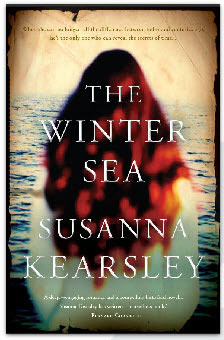Recently (thanks to a weather delay) I had some extra time to browse in the New York Times Bookstore at the Providence airport. If I’d been rushing, I would’ve missed The Winter Sea by Susanna Kearsley; the book was spine-out and the cover too gothic for my usual reading tastes. But the word “sea” caught my eye, and once I read the premise (historical novel bound up with present day writer’s story), I was intrigued enough to buy it.
I’m not too particular about my airplane reading, but I got so lost in this thick book that I even forgot to nap on the long flight to California. By the time the wheels touched down, I’d figured out the “surprise ending” promised by one reviewer—not knowing that yet another surprise had been layered into the final pages. With fresh writing, more than a sprinkle of romance, and a tangled thread weaving past to present, this books is one of the best I’ve read all year.
But now I have a problem. Kearsley’s characters have crossed over the line in my brain that separates reader from writer.
I’ve been digging into my next project—which is at present no more than a bunch of seemingly unrelated ideas. I’ve got a main character, though he keeps trying to work his way out of the limelight. I’ve got a girlfriend obsessed with her ancestors, even though those ancestors can’t seem to lock into a country of origin. I’ve got a box, though I’m not sure what’s in it, and I’ve got a problem to solve. All I need is the right “hurricane” to stir it all together.
Searching for inspiration, my thoughts turned back to The Winter Sea. A historical novel binding together past and present—just what I’m trying to write. So I figured I’d reread it, to see how someone else got the job done.
Calling it research, I sat down to read again. I forced myself to step back from the onrush of “what happens next” to study the details— how they oh so casually piled up to create an impression of character, place, and time.
It was a lovely escape. Until I realized that my writerly daydreaming was focused on Kearsley’s characters instead of my own.
I’m not writing about eighteenth century Scotland (though I’d really like to visit someday). And I’m not writing about a writer, though I will recommend this book to the next person who asks me, “Where do you get your ideas?” The main character, Carrie, answers that question better than I ever could:
“The main ideas for my novels never struck me like a lightning bolt. They formed themselves in stages, like a snowball packed in layers, with clumps padded on here and lumps scraped away there, till the whole thing was rounded and perfect. But by then, I could no longer see the shape of that first handful I’d scooped up, that first small thought that had begun the process.”
Now I find my own snowball has been melted away by my reading. I need to struggle with my own ideas right now, not bask in the seemingly effortless word choices of another.
So I’ve made a vow: No more Kearsley (though she has a mouth-watering backlist) until I know how my own story ends.
For so many reasons, I pray that knowledge will come soon.